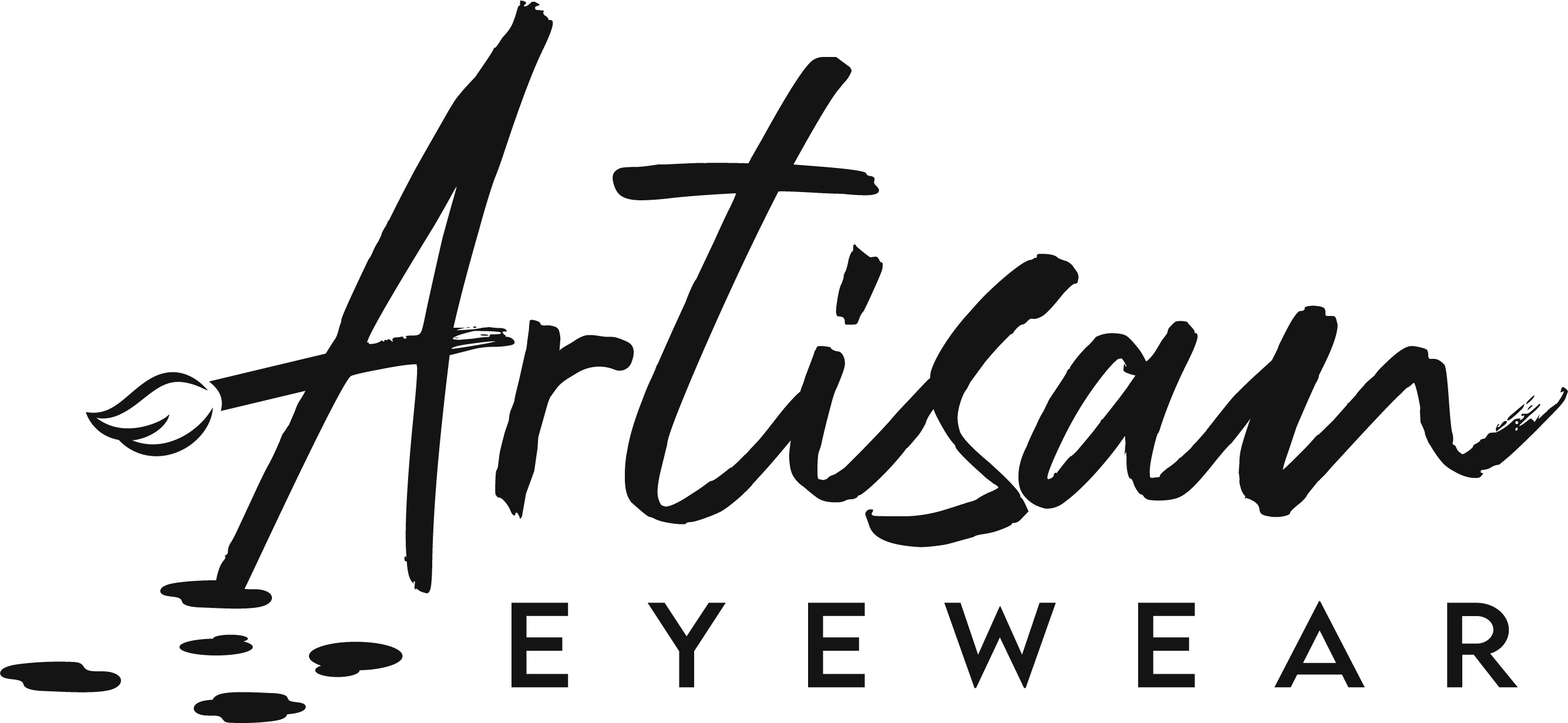Progressive Lenses: How to Troubleshoot Common Problems
by Natalie Taylor, LDO
Part II on Progressive Lenses
If you’ve clicked on this article, chances are good you’ve recently purchased new progressive lenses and things are not 100% perfect. In the next segment, I’ll walk you through a series of considerations. Use this information when returning to your optician for troubleshooting, it may help him or her know how to help. It may go without saying, but this should be a compelling reason not to purchase online eye wear. Your optician is a key to your success with progressive lenses!
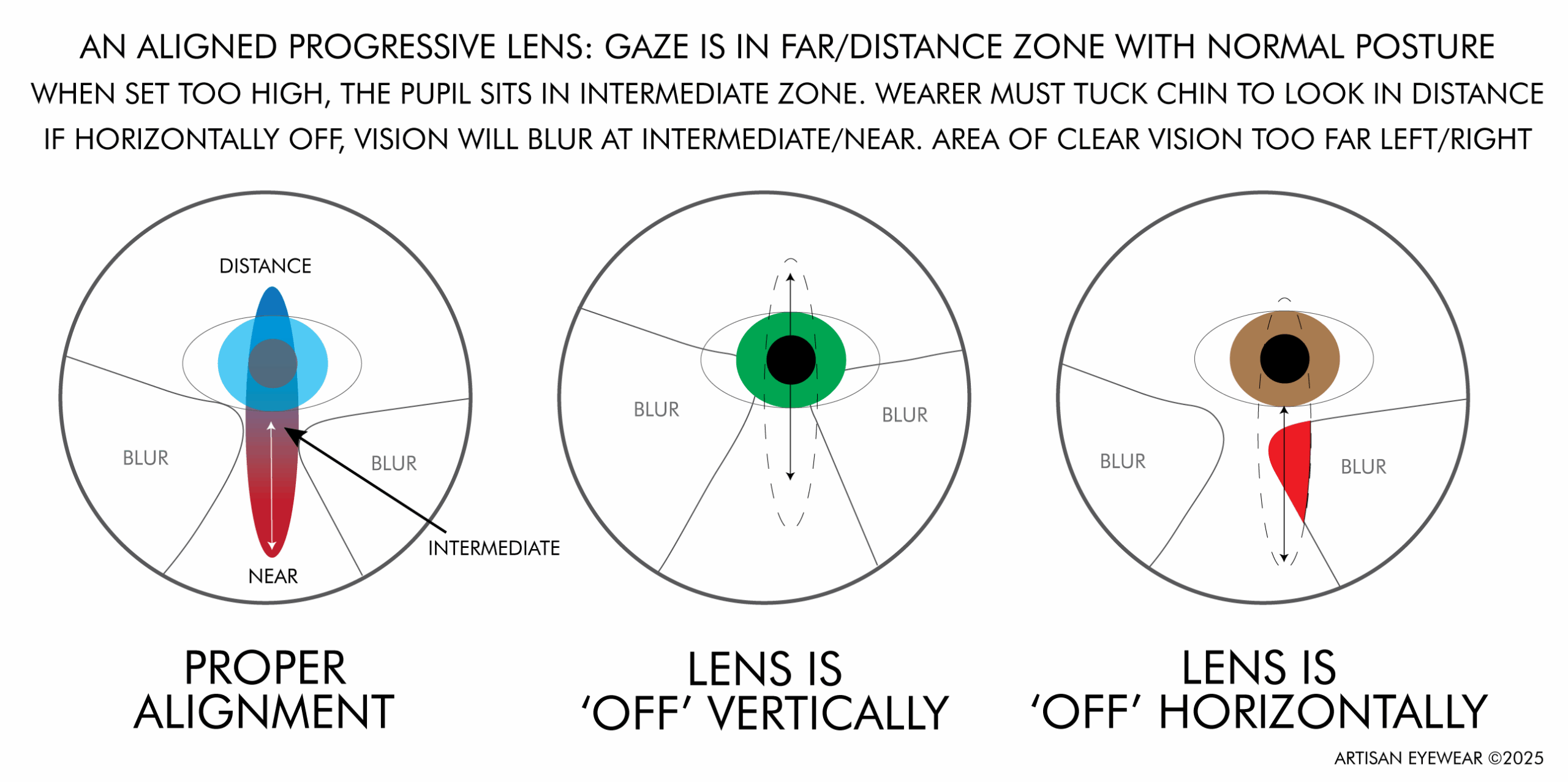
The ‘height’ is too low or too high
Your optician took this measurement while you were wearing your new frame; it is unique to the frame. This determines the vertical layout of the progressive addition: ideally, with natural straight head posture looking at the horizon, you should be using your far-away prescription. As your gaze travels down, your vision will pass through the intermediate zone and into your close-up power. In an average exam your doctor will measure a close-up power meant for 14 inches (or 40 cm) from the front of the eye to the object.
When your progressive sits too high, you’re looking at the horizon through the intermediate zone and have to tuck your chin and look higher in the lens for your far-away power.
When the progressive sits too low, you are raising your chin and looking down in an uncomfortable angle to find your intermediate and close-up zones. If your frame has nose pads, it might be possible to adjust the frame to properly line up with your eyes. Otherwise, the lenses will likely need to be remade.
The corridor isn’t lined up
Your optician likely took pupillary distance measurements using a tool. This gives horizonal coordinates for your pupils. Progressive lenses have what we refer to as a ‘corridor,’ a vertical band of ‘good vision’ which needs to line up perfectly to your pupils. This measurement (ideally) would be taken monocularly at both distance and near. If you have to turn your head horizontally to catch the ‘good’ vision, take note if this is true both far-away and close-up. The lenses will likely need to be remade.
If you can see ‘okay’ in the bottom of the lens, consider if the ADD power is too weak.
The “Sweet Spot” or zone of good vision feels too small
This is typically an experience that gets better with time. For three days, please do the following: wear the glasses ‘full time’ and don’t switch back and forth with an older pair; move around a lot – go for walks or a hike; use brighter lighting than you normally would for near tasks. If after three days you still feel the area of good vision is too small, please report to your optician and share your experience.
Pincushion or barrel distortion
This experience isn’t unique to progressive lenses: upon wearing a new prescription, the ‘world’ looks misshapen. The pincushion effect can happen to people who are hyperopic or farsighted, where the corners of the world are magnified and extend out. The barrel effect is more a myopic effect, where the corners are less magnified and the sides ‘bulge’ out.
It is not unusual; your brain should learn how to use your lenses during your initial period of wear, but if your eyes haven’t adjusted after two weeks, talk to your optician about adjustment or even selecting a different frame.
If there is a lot of ‘face form’ — if the front of the frame is quite curved — this might be the culprit. There are a small number of progressive designs made for a ‘wrap’ frame, but a strong prescription won’t perform as well in a frame this shape.
Peripheral blur
If the outer edges of your progressive lens are blurry – this is actually normal! The physical nature of lenses that contain this blend of powers requires aberration, which designers push into the periphery. They do this because realistically, the far edges of the lens are not typically looked through. Higher-quality (and higher-priced) lenses will have less peripheral blur on the whole. After 1 to 3 weeks of constant wear, your brain will adapt to and ignore the blur, the same way it ‘doesn’t see’ your nose (until you start thinking about it, that is!).
The vision makes your eyes hurt, or feel dry, or there’s a pulling sensation
I’d recommend asking an eye care professional to check for prism, either prescribed or unwanted. Researchers have found prism can affect pain receptors. This includes nausea, dizziness, intermittent double vision (relieved by closing one eye), and other complaints that are more about how you feel than what you see.
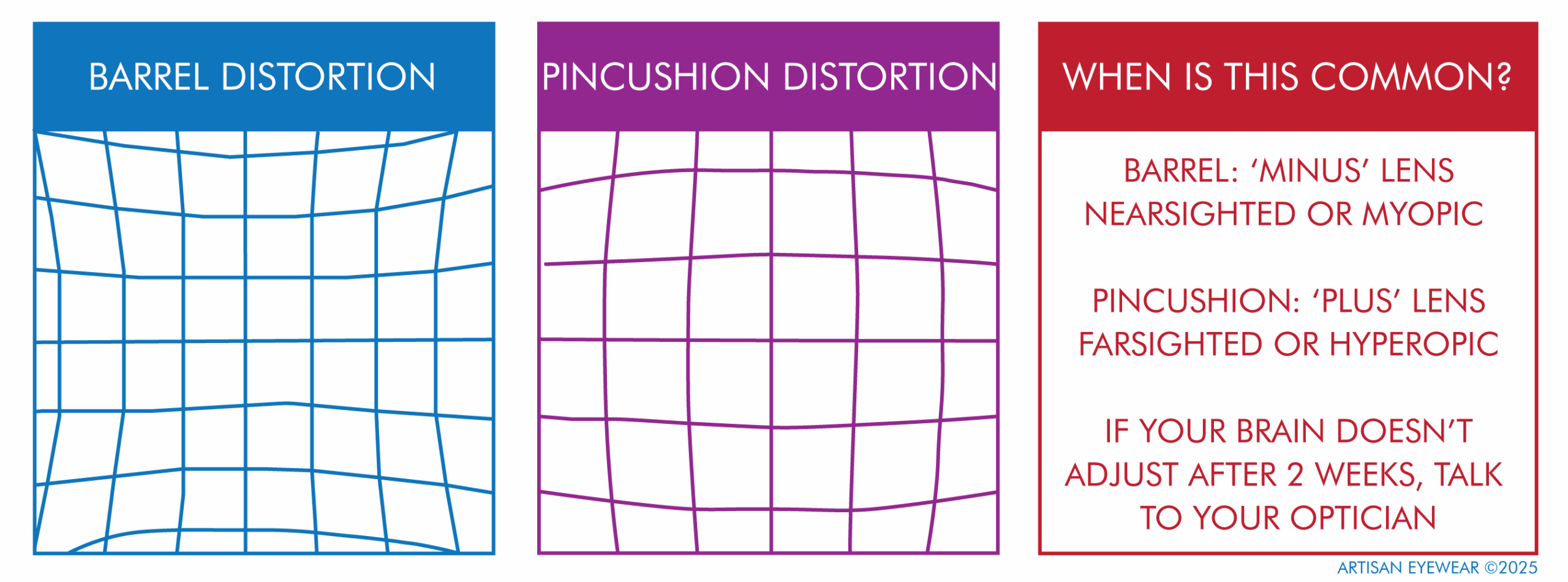
If your vision is just darn blurry
Check each eye by itself; look through every area of each lens; go slooooowly. If you can’t catch a reasonably clear area anywhere, ask your optician to check the prescription. Bring a pair of glasses you DO see well with and ask them to compare. Sometimes, the doctor or doctor’s assistant can transpose numbers or make another clerical error and that error gets made into lenses.
Lens material can also contribute; if your lenses are polycarbonate, changing to a different material like Trivex could remedy the situation. A professional frame adjustment can fix blurry vision as well.
If your vision is intermittently blurry
Maybe everything looks great in the morning, but as the day goes on things get challenging. If you have dry eye, meibomian gland stasis, blepharitis or a related condition, it’s possible your eye health is affecting your vision. This is a good reason to schedule a medical appointment with your optometrist. Medication side effects, medical conditions like Sjogren’s, and other factors can create sudden and rapid vision changes.
You’re seeing double
First, use a hand to cover one eye at a time to test if you’re seeing double only with both eyes open, or if you see double even with one eye covered. If the onset is sudden, and/or you’re seeing double even when covering one eye, treat this as a time-sensitive emergency.
If you only see double when wearing your new glasses, your optician will want to check for unwanted prism, adjust the frame, and do other checks to your lenses. No need to give your brain time to adapt on this one, you aren’t supposed to see double.
If you have a very large difference in power between your left and right eyes, progressives may not be right for you. Some people successfully use what’s called a slab-off lens, but this is a specialty product you should discuss with your doctor or an experienced optician.
Also to note:
If your progressives lenses are not level on your face and sitting where your optician took measurements, they won’t work correctly. Imagine looking through invisible keyholes — your lenses need to be lined up with your pupils. If your frame is crooked, or sliding down your nose, visit your optician for an adjustment.
Your glasses were fine when you first got them, but things have gotten worse
A quick and simple check is cleaning your lenses! Use a clean microfiber cloth and lens spray. You can also use warm water and a drop of Dawn dish liquid. If you haven’t washed your cloth in a while, that’s likely the culprit.
The next thing would be to look at your lenses in bright light at a 30-45 degree angle. Examine the surface of the lenses: is there a pattern of ‘cracks’ that look stretched? That is called ‘crazing’ and it happens when lenses are exposed to high heat. No amount of cleaning will clear that haze and the lenses will need to be remade; if you’re a client of Artisan Eyewear your lenses are warrantied for two years.
Lastly, consider medical reasons: are you taking a medication and experiencing a side effect? Is something developing, like cataracts, dry eye, or a corneal issue? Before contacting a provider, make note of other symptoms like dizziness or headaches.
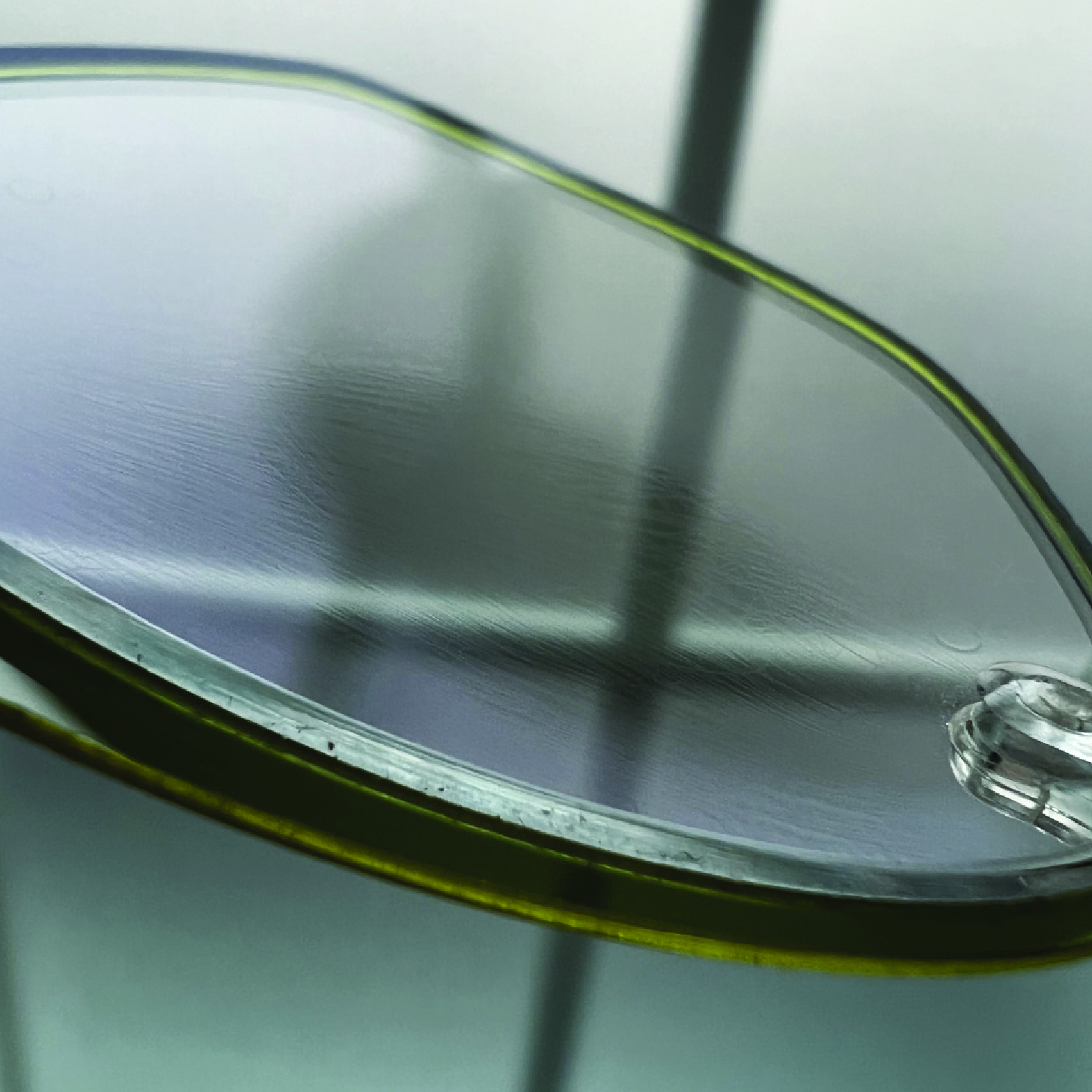
These lenses have crazed
So… What does “Normal” feel like???
When I started wearing progressives, I noticed the objects in my periphery looked strange when I moved my head quickly. My eyes wanted to stay in the ‘corridor’ or the vertical column of good vision, which meant I had to move my head more than normal. It felt a bit like mimicking an owl! After a day like this, my eyes didn’t feel quite so restrained within the corridor, but I was still aware of the funny business at the corners of my vision. I would say it took a full three weeks before every oddity disappeared and the lenses felt like a part of me.
For most progressive wearers, the first pair contains the longest learning curve.
How to Speed Up Adaptation
The best thing you can do when you first get your new progressive lenses is to move around: clean the house, garden, walk the dog. Your brain needs time to learn how to use these lenses in a “3D environment” so while it isn’t going to hurt to sit at your computer or desk for several hours, it isn’t going to positively contribute to your goal.
When you use your new progressive lenses, you will want to point your nose/chin at your ‘visual target.’ It may feel awkward at first, but the eyes lead the body and things will sync up soon enough. There will be activities made harder by progressives, for example if you are used to laying flat in bed while watching television you may find you now need to sit up a bit so you can look through the top of the lens.
If you are normally prone to nausea or have a hypersensitive visual system, the first weeks with new progressive lenses might be more of a challenge. It’s okay to ease into wear: a few hours the first day, and add a few more hours throughout the week. Wearing them first thing in the morning, right when you wake up, is easier on your visual system. Progressive lenses are always designed for both eyes to work together, and it’s quite normal for one eye to see slightly better than the other — the important bit is that you see clearly and comfortably with both eyes together.
When to Replace or Re-evaluate Your Progressives
Eye exams are recommended every 1-2 years to keep on top of medical developments as well as changes to your eyeglass prescription. The decision to refresh your lenses is often influenced by a subjective remark from your eye doctor: “It’s a small change, I wouldn’t bother” vs “It’s a small change, but I think you’ll notice a difference.” Whenever possible, ask your optometrist or ophthalmologist if the new prescription can be placed into a trial frame at the end of your eye exam so you can walk around the exam room (better yet, walk around the office! Look out the window!) and do a ‘before and after’ with your old pair. [This won’t work if your eyes are dilated]
Here at Artisan Eyewear, I often will do this with clients when we first meet to ensure (1) there were no transposition errors (2) there’s a noticeable improvement over the previous script. Of course, there’s nothing wrong with updating simply to pick a new frame and a new look!
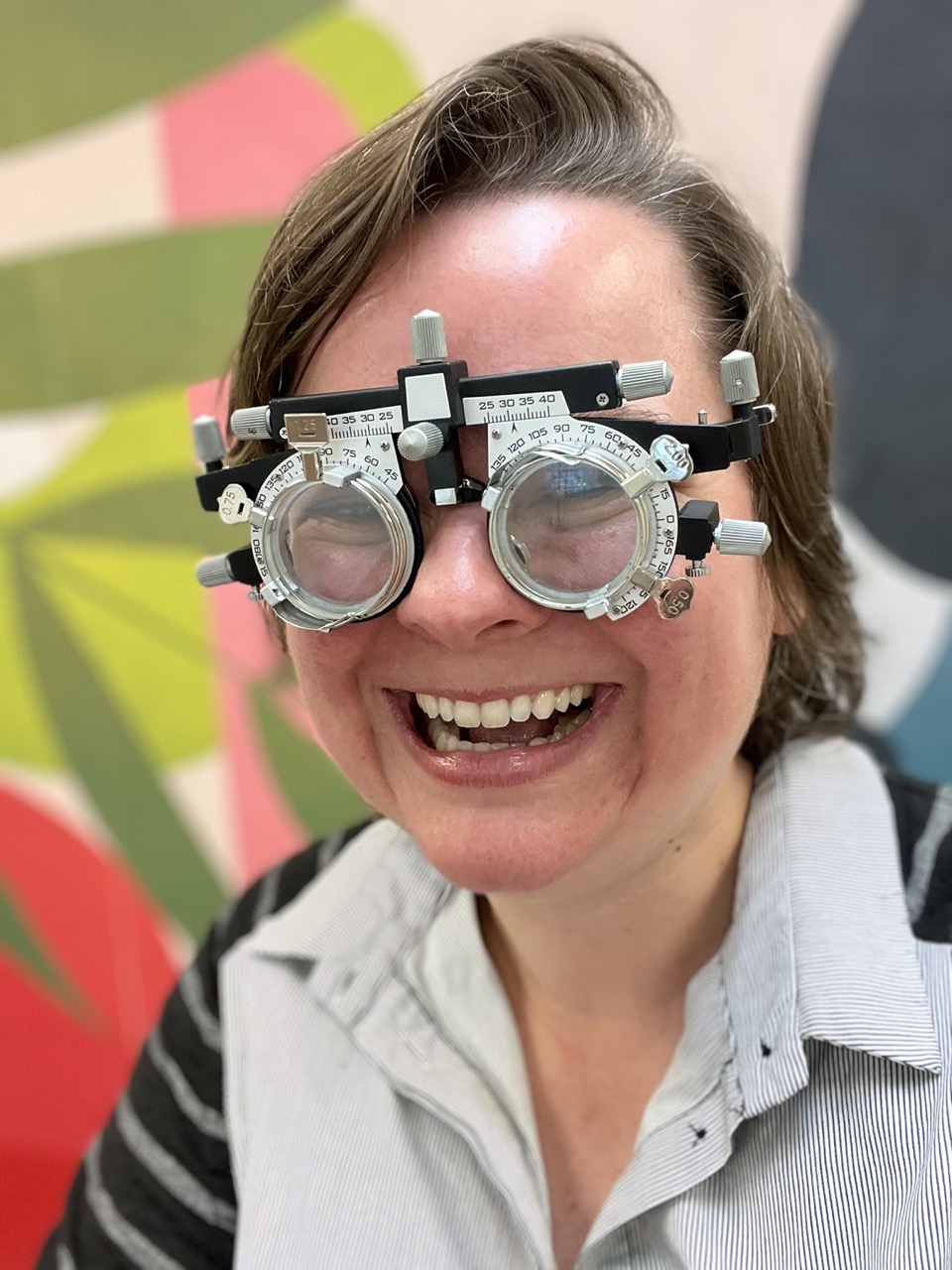
Optician Natalie demonstrating the fashion statement that is a trial frame
When re-evaluating your progressives, ask yourself:
-
-
- When am I taking my glasses off during the day?
- What tasks am I still visually struggling with when wearing these progressives? In which ways?
- Are you straining your neck on the computer?
- Are you tilting your chin high to read?
- Are you tucking your chin when driving?
- Did the nature of your job or hobbies change significantly, creating a new need for computer-specific lenses or single-vision lenses?
-
This information may influence your optician to use a different progressive design in your next pair.
Adjusting to your first pair of progressive lenses can take time, but persistent problems shouldn’t be ignored. With the right guidance and support from your optician, many common issues can be resolved or improved. Keep track of your experiences and speak up — your feedback is key to fine-tuning your eyewear for clear, comfortable vision.
Artisan Eyewear is located at 309 Main Street in Norwich, Vermont. (802) 526-3245
